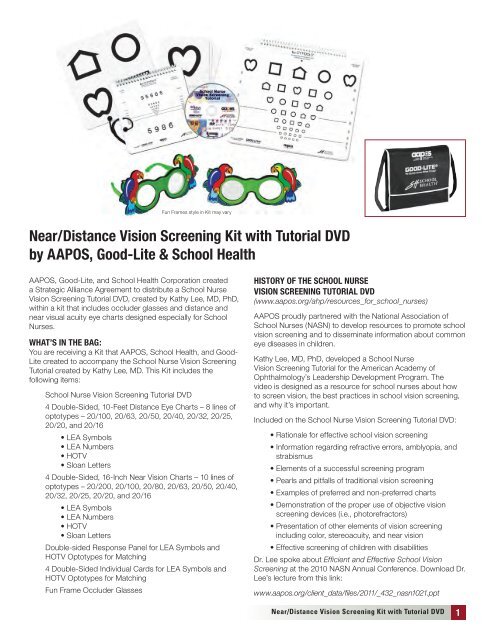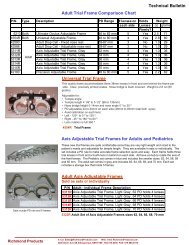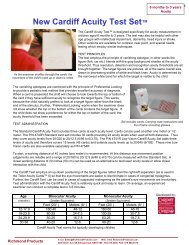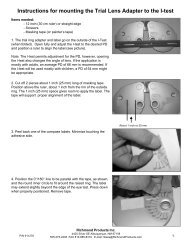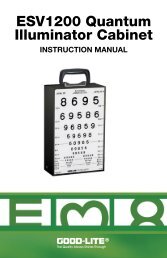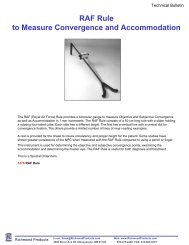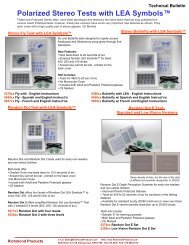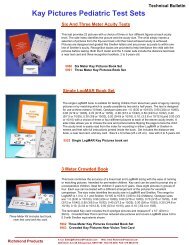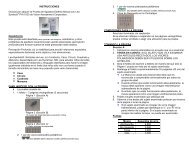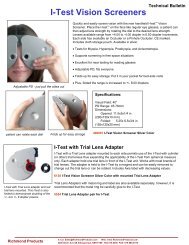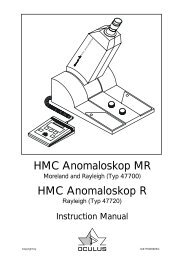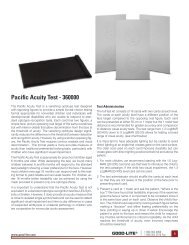Near/Distance Vision Screening Kit with Tutorial DVD by AAPOS ...
Near/Distance Vision Screening Kit with Tutorial DVD by AAPOS ...
Near/Distance Vision Screening Kit with Tutorial DVD by AAPOS ...
Create successful ePaper yourself
Turn your PDF publications into a flip-book with our unique Google optimized e-Paper software.
Fun Frames style in <strong>Kit</strong> may vary<br />
<strong>Near</strong>/<strong>Distance</strong> <strong>Vision</strong> <strong>Screening</strong> <strong>Kit</strong> <strong>with</strong> <strong>Tutorial</strong> <strong>DVD</strong><br />
<strong>by</strong> <strong>AAPOS</strong>, Good-Lite & School Health<br />
<strong>AAPOS</strong>, Good-Lite, and School Health Corporation created<br />
a Strategic Alliance Agreement to distribute a School Nurse<br />
<strong>Vision</strong> <strong>Screening</strong> <strong>Tutorial</strong> <strong>DVD</strong>, created <strong>by</strong> Kathy Lee, MD, PhD,<br />
<strong>with</strong>in a kit that includes occluder glasses and distance and<br />
near visual acuity eye charts designed especially for School<br />
Nurses.<br />
WHAT’S IN THE BAG:<br />
You are receiving a <strong>Kit</strong> that <strong>AAPOS</strong>, School Health, and Good-<br />
Lite created to accompany the School Nurse <strong>Vision</strong> <strong>Screening</strong><br />
<strong>Tutorial</strong> created <strong>by</strong> Kathy Lee, MD. This <strong>Kit</strong> includes the<br />
following items:<br />
School Nurse <strong>Vision</strong> <strong>Screening</strong> <strong>Tutorial</strong> <strong>DVD</strong><br />
4 Double-Sided, 10-Feet <strong>Distance</strong> Eye Charts – 8 lines of<br />
optotypes – 20/100, 20/63, 20/50, 20/40, 20/32, 20/25,<br />
20/20, and 20/16<br />
• LEA Symbols<br />
• LEA Numbers<br />
• HOTV<br />
• Sloan Letters<br />
4 Double-Sided, 16-Inch <strong>Near</strong> <strong>Vision</strong> Charts – 10 lines of<br />
optotypes – 20/200, 20/100, 20/80, 20/63, 20/50, 20/40,<br />
20/32, 20/25, 20/20, and 20/16<br />
• LEA Symbols<br />
• LEA Numbers<br />
• HOTV<br />
• Sloan Letters<br />
Double-sided Response Panel for LEA Symbols and<br />
HOTV Optotypes for Matching<br />
4 Double-Sided Individual Cards for LEA Symbols and<br />
HOTV Optotypes for Matching<br />
Fun Frame Occluder Glasses<br />
HISTORY OF THE SCHOOL NURSE<br />
VISION SCREENING TUTORIAL <strong>DVD</strong><br />
(www.aapos.org/ahp/resources_for_school_nurses)<br />
<strong>AAPOS</strong> proudly partnered <strong>with</strong> the National Association of<br />
School Nurses (NASN) to develop resources to promote school<br />
vision screening and to disseminate information about common<br />
eye diseases in children.<br />
Kathy Lee, MD, PhD, developed a School Nurse<br />
<strong>Vision</strong> <strong>Screening</strong> <strong>Tutorial</strong> for the American Academy of<br />
Ophthalmology’s Leadership Development Program. The<br />
video is designed as a resource for school nurses about how<br />
to screen vision, the best practices in school vision screening,<br />
and why it’s important.<br />
Included on the School Nurse <strong>Vision</strong> <strong>Screening</strong> <strong>Tutorial</strong> <strong>DVD</strong>:<br />
• Rationale for effective school vision screening<br />
• Information regarding refractive errors, amblyopia, and<br />
strabismus<br />
• Elements of a successful screening program<br />
• Pearls and pitfalls of traditional vision screening<br />
• Examples of preferred and non-preferred charts<br />
• Demonstration of the proper use of objective vision<br />
screening devices (i.e., photorefractors)<br />
• Presentation of other elements of vision screening<br />
including color, stereoacuity, and near vision<br />
• Effective screening of children <strong>with</strong> disabilities<br />
Dr. Lee spoke about Efficient and Effective School <strong>Vision</strong><br />
<strong>Screening</strong> at the 2010 NASN Annual Conference. Download Dr.<br />
Lee’s lecture from this link:<br />
www.aapos.org/client_data/files/2011/_432_nasn1021.ppt<br />
<strong>Near</strong>/<strong>Distance</strong> <strong>Vision</strong> <strong>Screening</strong> <strong>Kit</strong> <strong>with</strong> <strong>Tutorial</strong> <strong>DVD</strong> 1
DIRECTIONS FOR DISTANCE VISION EYE CHARTS<br />
LEA Symbols and HOTV:<br />
Though these directions are for both LEA Symbols and HOTV<br />
optotypes, you need not complete both tests. You have the<br />
option of using LEA Symbols or HOTV optotypes.<br />
Measure testing distance <strong>with</strong> 10 feet between the chart and<br />
the child’s eyes.<br />
Establish a method of communication, such as naming,<br />
signing, or pointing at the appropriate Response Panel or<br />
Individual Cards for matching.<br />
Use the Response Panel close to the child to familiarize the<br />
child <strong>with</strong> the task. For LEA Symbols, decide <strong>with</strong> the child<br />
what names will be used to identify the optotypes. If using<br />
HOTV and the child does not know the letters, use the HOTV<br />
Response Panel for matching. Matching is an option for both<br />
LEA Symbols and HOTV. Another matching option is to place<br />
the 4 Individual Cards on the floor in front of the child and ask<br />
the child to step on the card that matches the optotype on<br />
your chart. Never use the Response Panel or the Individual<br />
Cards to assess visual acuity. If you use the Individual Cards<br />
for matching, place them in front of the child only when you are<br />
ready to screen vision.<br />
Occlude the child’s eyes <strong>with</strong> Fun Frames Occluder Glasses.<br />
If child is wearing prescription spectacles, screen <strong>with</strong> glasses<br />
on, and occluder glasses over prescription glasses. While not<br />
required, most screening begins <strong>by</strong> occluding the left eye and<br />
testing the right eye first.<br />
Begin screening <strong>by</strong> asking the child to identify, or match, the<br />
left optotype on the 20/100 line. Do not point to the optotype<br />
and hold the pointer near the optotype while waiting for the<br />
child to identify the optotype. You can point to the line of<br />
optotypes, or briefly point<br />
beneath the optotype you<br />
want the child to identify,<br />
and immediately remove<br />
the pointer.<br />
Continue identifying the<br />
left optotype on each line<br />
down the chart until the<br />
child misses an optotype.<br />
Return to the line above<br />
the missed optotype and<br />
ask the child to identify/<br />
match optotypes on that<br />
line.<br />
Move to the next line<br />
down and ask the child to<br />
identify/match optotypes<br />
on each line until the<br />
child misses 3 or more<br />
optotypes.<br />
LEA Symbols and HOTV<br />
<strong>Distance</strong> Chart<br />
• Passing = Identifying/matching correctly 3 of 5 optotypes.<br />
• Not Passing = Missing 3 or more optotypes.<br />
Visual acuity is recorded as the last line on which at least 3 of 5<br />
optotypes were identified/matched correctly.<br />
This is a 10-foot test. The number you record is the 20-foot<br />
notation in the right margin adjacent to the last line on which 3<br />
of 5 optotypes were identified/matched correctly.<br />
Referral criteria will depend on your guidelines. The American<br />
Academy of Pediatrics, the American Association of<br />
Certified Orthoptists, the American Association for Pediatric<br />
Ophthalmology and Strabismus, and the American Academy<br />
of Ophthalmology recommend that children ages 3, 4, and 5<br />
should be able to identify 3 of 5 optotypes on the 20/40 line<br />
and children ages 6 and older should be able to identify 3 of 5<br />
optotypes on the 20/32 line.<br />
DIRECTIONS FOR DISTANCE VISION EYE CHARTS<br />
LEA Numbers and Sloan Letters:<br />
Though these directions are for both LEA Numbers and Sloan<br />
Letters, you need not complete both tests. You have the option<br />
of using either test.<br />
Measure testing distance <strong>with</strong> 10 feet between the chart and<br />
the child’s eyes.<br />
Occlude the child’s eyes. If child is wearing prescription<br />
spectacles, screen <strong>with</strong> glasses on, and occluder over<br />
prescription glasses. While not required, most screening begins<br />
<strong>by</strong> occluding the left eye and testing the right eye first.<br />
Begin <strong>by</strong> asking the child to identify the left optotype on the<br />
20/100 line. Do not point to the optotype and hold the pointer<br />
near the optotype while<br />
waiting for the child to<br />
identify the optotype. You<br />
can point to the line of<br />
optotypes, or briefly point<br />
beneath the optotype you<br />
want the child to identify,<br />
and immediately remove<br />
the pointer.<br />
Continue identifying the<br />
left optotype on each line<br />
down the chart until the<br />
child misses an optotype.<br />
Return to the line above<br />
the missed optotype and<br />
ask the child to identify<br />
optotypes on that line.<br />
Move to the next line<br />
down and ask the child<br />
to identify optotypes<br />
on each line until the<br />
child misses 3 or more<br />
optotypes.<br />
LEA Numbers and Sloan<br />
Letters <strong>Distance</strong> Chart<br />
2<br />
<strong>Near</strong>/<strong>Distance</strong> <strong>Vision</strong> <strong>Screening</strong> <strong>Kit</strong> <strong>with</strong> <strong>Tutorial</strong> <strong>DVD</strong>
ACTUAL<br />
SIZE<br />
10/50<br />
10/32<br />
10/25<br />
10/20<br />
10/16<br />
10/12.5<br />
10/10<br />
10/8<br />
Developed <strong>by</strong> Lea Hyvärinen, M.D.<br />
FOR TESTING AT 10 FEET<br />
a s h c a<br />
h s a s c<br />
a c s a h<br />
c s c h a<br />
s c s a h<br />
c s a h c<br />
h a s c a<br />
a h c s c<br />
DISTANCE<br />
EQUIVALENT<br />
20/100<br />
20/63<br />
20/50<br />
20/40<br />
20/32<br />
20/25<br />
20/20<br />
20/16<br />
ACTUAL<br />
SIZE<br />
10/50<br />
10/32<br />
10/25<br />
10/20<br />
10/16<br />
10/12.5<br />
10/10<br />
10/8<br />
HOTV NEAR VISION CHART IN LogMAR SIZES<br />
FOR TESTING AT 10 FEET<br />
H O V T H<br />
T V T H O<br />
V O H V T<br />
O T V T H<br />
H O T V O<br />
T H V O H<br />
V O H V T<br />
O V T H V<br />
DISTANCE<br />
EQUIVALENT<br />
20/100<br />
20/63<br />
20/50<br />
20/40<br />
20/32<br />
20/25<br />
20/20<br />
20/16<br />
GOOD-LITE<br />
The Quality Always Shines Through<br />
<strong>Distance</strong> <strong>Vision</strong> Answer Key<br />
D
ACTUAL<br />
SIZE<br />
Developed <strong>by</strong> Lea Hyvärinen, M.D.<br />
FOR TESTING AT 10 FEET<br />
DISTANCE<br />
EQUIVALENT<br />
10/50<br />
10/32<br />
10/25<br />
10/20<br />
10/16<br />
10/12.5<br />
10/10<br />
10/8<br />
6+9+5+8+9<br />
5+9+6+9+8<br />
6+8+9+6+5<br />
8+9+8+5+6<br />
9+8+5+6+9<br />
8+9+6+5+8<br />
5+6+9+8+6<br />
6+5+8+9+8<br />
20/100<br />
20/63<br />
20/50<br />
20/40<br />
20/32<br />
20/25<br />
20/20<br />
20/16<br />
ACTUAL<br />
SIZE<br />
10/50<br />
10/32<br />
10/25<br />
10/20<br />
10/16<br />
10/12.5<br />
10/10<br />
10/8<br />
SLAON LETTERS IN LogMAR SIZES<br />
FOR TESTING AT 10 FEET<br />
K C R H O<br />
H V O R K<br />
R S H O N<br />
O K S V Z<br />
K S N H O<br />
H O V S N<br />
V C S Z H<br />
C Z D R V<br />
DISTANCE<br />
EQUIVALENT<br />
20/100<br />
20/63<br />
20/50<br />
20/40<br />
20/32<br />
20/25<br />
20/20<br />
20/16<br />
GOOD-LITE<br />
The Quality Always Shines Through<br />
D<br />
<strong>Distance</strong> <strong>Vision</strong> Answer Key
LETTER SIZE<br />
4.0 M<br />
Developed <strong>by</strong> Lea Hyvärinen, M.D.<br />
FOR TESTING AT 16 INCHES (40 CM)<br />
DISTANCE<br />
EQUIVALENT<br />
20/200<br />
2.0 M<br />
20/100<br />
1.6 M<br />
20/80<br />
1.25 M<br />
20/63<br />
1.0 M<br />
.80 M<br />
.63 M<br />
20/50<br />
20/40<br />
20/32<br />
.50 M<br />
20/25<br />
.40 M<br />
.32 M<br />
20/20<br />
20/16<br />
LETTER SIZE<br />
4.0 M<br />
HOTV NEAR VISION CHART IN LogMAR SIZES<br />
FOR TESTING AT 16 INCHES (40 CM)<br />
DISTANCE<br />
EQUIVALENT<br />
20/200<br />
2.0 M<br />
20/100<br />
1.6 M<br />
20/80<br />
1.25 M<br />
20/63<br />
1.0 M<br />
.80 M<br />
20/50<br />
20/40<br />
.63 M<br />
20/32<br />
.50 M<br />
.40 M<br />
.32 M<br />
20/25<br />
20/20<br />
20/16<br />
GOOD-LITE<br />
The Quality Always Shines Through<br />
<strong>Near</strong> <strong>Vision</strong> Answer Key<br />
N
LETTER SIZE<br />
4.0 M<br />
Developed <strong>by</strong> Lea Hyvärinen, M.D.<br />
FOR TESTING AT 16 INCHES (40 CM)<br />
DISTANCE<br />
EQUIVALENT<br />
20/200<br />
2.0 M<br />
20/100<br />
1.6 M<br />
20/80<br />
1.25 M<br />
20/63<br />
1.0 M<br />
.80 M<br />
20/50<br />
20/40<br />
.63 M<br />
20/32<br />
.50 M<br />
.40 M<br />
.32 M<br />
20/25<br />
20/20<br />
20/16<br />
LETTER SIZE<br />
4.0 M<br />
SLOAN LETTERS<br />
FOR TESTING AT 16 INCHES (40 CM)<br />
DISTANCE<br />
EQUIVALENT<br />
20/200<br />
2.0 M<br />
20/100<br />
1.6 M<br />
20/80<br />
1.25 M<br />
20/63<br />
1.0 M<br />
.80 M<br />
20/50<br />
20/40<br />
.63 M<br />
20/32<br />
.50 M<br />
.40 M<br />
.32 M<br />
20/25<br />
20/20<br />
20/16<br />
GOOD-LITE<br />
The Quality Always Shines Through<br />
N<br />
<strong>Near</strong> <strong>Vision</strong> Answer Key
• Passing = Identifying/matching correctly 3 of 5 optotypes.<br />
• Not Passing = Missing 3 or more optotypes.<br />
Visual acuity is recorded as the last line on which at least 3 of 5<br />
optotypes were identified correctly.<br />
This is a 10-foot test. The number you record is the 20-foot<br />
notation in the right margin adjacent to the last line on which 3<br />
of 5 optotypes were identified/matched correctly.<br />
Referral criteria will depend on your guidelines. The American<br />
Academy of Pediatrics, the American Association of<br />
Certified Orthoptists, the American Association for Pediatric<br />
Ophthalmology and Strabismus, and the American Academy<br />
of Ophthalmology recommend that children ages 6 and older<br />
should be able to identify 3 of 5 optotypes on the 20/32 line.<br />
DIRECTIONS FOR NEAR VISION EYE CHARTS<br />
LEA Symbols and HOTV:<br />
Though these directions are for both LEA Symbols and HOTV<br />
optotypes, you need not complete both tests. You have the<br />
option of using LEA Symbols or HOTV optotypes. If you choose<br />
to begin near visual acuity screening <strong>with</strong> binocular testing,<br />
follow the directions for monocular testing below.<br />
Testing distance is 16-inches between the chart and the child’s<br />
eyes. Use attached cord to measure distance.<br />
Establish a method of communication, such as naming,<br />
signing, or pointing for matching.<br />
Use the 4 large optotypes at the bottom of the chart to<br />
familiarize the child <strong>with</strong> the task. For LEA Symbols, decide<br />
<strong>with</strong> the child what names will be used to identify the<br />
optotypes. Matching is an option for both LEA Symbols and<br />
HOTV optotypes.<br />
Occlude the child’s eyes <strong>with</strong> Fun Frames Occluder Glasses.<br />
If child is wearing prescription spectacles, screen <strong>with</strong> glasses<br />
on, and occluder glasses over prescription glasses. While not<br />
required, most screening begins <strong>by</strong> occluding the left eye and<br />
testing the right eye first.<br />
Begin <strong>by</strong> asking the child to identify, or match, the left optotype<br />
on the 20/200 line. Do not point to the optotype and hold the<br />
pointer near the optotype while waiting for the child to identify<br />
the optotype. You can point to the line of optotypes, or briefly<br />
point beneath the optotype you want the child to identify, and<br />
immediately remove the pointer.<br />
Continue identifying the left optotype on each line down the<br />
chart until the child misses an optotype.<br />
Return to the line above the missed optotype and ask the child<br />
to identify/match optotypes on that line.<br />
Move to the next line down and ask the child to identify/<br />
match optotypes on each line until the child misses 3 or more<br />
optotypes.<br />
• Passing = Identifying/matching correctly 3 of 5 optotypes.<br />
• Not Passing = Missing 3 or more optotypes.<br />
Visual acuity is recorded as the last line on which at least 3 of 5<br />
optotypes were identified/matched correctly.<br />
This is a 16-inch test. The number you record is the 20-foot<br />
notation in the right margin adjacent to the last line on which 3<br />
of 5 optotypes were identified correctly.<br />
Referral criteria will depend on your guidelines. Referral criteria<br />
for near vision screening typically follows that of distance visual<br />
acuity screening. For distance visual acuity screening, the<br />
American Academy of Pediatrics, the American Association of<br />
Certified Orthoptists, the American Association for Pediatric<br />
Ophthalmology and Strabismus, and the American Academy<br />
of Ophthalmology recommend that children ages 3, 4, and 5<br />
should be able to identify 3 of 5 optotypes on the 20/40 line<br />
and children ages 6 and older should be able to identify 3 of 5<br />
optotypes on the 20/32 line.<br />
DIRECTIONS FOR NEAR VISION EYE CHARTS<br />
LEA Numbers and Sloan Letters:<br />
Though these directions are for both LEA Numbers and Sloan<br />
Letters, you need not complete both tests. You have the<br />
option of using either test. If you choose to begin near visual<br />
acuity screening <strong>with</strong> binocular testing, follow the directions for<br />
monocular testing below.<br />
Testing distance is 16-inches between the chart and the child’s<br />
eyes. Use attached cord to measure distance.<br />
Occlude the child’s eyes. If child is wearing prescription<br />
spectacles, screen <strong>with</strong> glasses on, and occluder over<br />
LEA Symbols and HOTV <strong>Near</strong> <strong>Vision</strong> Chart<br />
LEA Numbers and Sloan Letters <strong>Near</strong> <strong>Vision</strong> Chart<br />
<strong>Near</strong>/<strong>Distance</strong> <strong>Vision</strong> <strong>Screening</strong> <strong>Kit</strong> <strong>with</strong> <strong>Tutorial</strong> <strong>DVD</strong> 3
prescription glasses. While not required, most screening begins<br />
<strong>by</strong> occluding the left eye and testing the right eye first.<br />
Begin <strong>by</strong> asking the child to identify the left optotype on the<br />
20/200 line. Do not point to the optotype and hold the pointer<br />
near the optotype while waiting for the child to identify the<br />
optotype. You can point to the line of optotypes, or briefly<br />
point beneath the optotype you want the child to identify, and<br />
immediately remove the pointer.<br />
Continue identifying the left optotype on each line down the<br />
chart until the child misses an optotype.<br />
Return to the line above the missed optotype and ask the child<br />
to identify optotypes on that line.<br />
Move to the next line down and ask the child to identify<br />
optotypes on each line until the child misses 3 or more<br />
optotypes.<br />
• Passing = Identifying/matching correctly 3 of 5 optotypes.<br />
• Not Passing = Missing 3 or more optotypes.<br />
Visual acuity is recorded as the last line on which at least 3 of 5<br />
optotypes were identified correctly.<br />
This is a 16-inch test. The number you record is the 20-foot<br />
notation in the right margin adjacent to the last line on which 3<br />
of 5 optotypes were identified correctly.<br />
Referral criteria will depend on your guidelines. Referral criteria<br />
for near vision screening typically follows that of distance visual<br />
acuity screening. For distance visual acuity screening, the<br />
American Academy of Pediatrics, the American Association of<br />
Certified Orthoptists, the American Association for Pediatric<br />
Ophthalmology and Strabismus, and the American Academy<br />
of Ophthalmology recommend that children ages 6 and older<br />
should be able to identify 3 of 5 optotypes on the 20/32 line.<br />
Purchase the <strong>Near</strong>/<strong>Distance</strong> <strong>Vision</strong><br />
<strong>Screening</strong> <strong>Kit</strong> <strong>with</strong> <strong>Tutorial</strong> <strong>DVD</strong> from<br />
either of these companies.<br />
Good-Lite: www.good-lite.com/visionkit<br />
Part Number: 110.................$60.00<br />
School Health: www.schoolhealth.com/visionkit<br />
Part Number: 52842 ..............$60.00<br />
Additional Resources<br />
American Association for Pediatric<br />
Ophthalmology and Strabismus<br />
www.aapos.org<br />
<strong>AAPOS</strong> Resources for School Nurses<br />
www.aapos.org/ahp/resources_for_school_nurses<br />
The Good-Lite Company<br />
www.good-lite.com<br />
The Good-Lite Company’s site for the School Nurse<br />
Community<br />
www.good-lite.com/communities/schoolnurse.cfm<br />
School Health Corporation<br />
www.schoolhealth.com<br />
School Health Corporation <strong>Vision</strong> <strong>Screening</strong> Resources<br />
for School Nurses<br />
www.schoolhealth.com/visionscreening<br />
4<br />
<strong>Near</strong>/<strong>Distance</strong> <strong>Vision</strong> <strong>Screening</strong> <strong>Kit</strong> <strong>with</strong> <strong>Tutorial</strong> <strong>DVD</strong>


